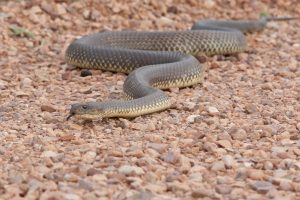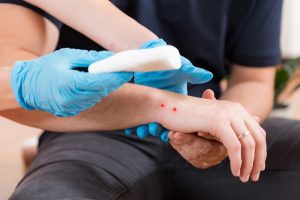How to stay safe when there are snakes about
Australia is home to more than 140 species of land snake and approximately 32 species of sea snakes.
About 100 Australian snakes are venomous and can cause moderate to severe symptoms with 12 types likely to inflict a wound that could kill.
Most snake bites occur when people accidentally step on or try to handle snakes, so the best advice is to be always be aware and steer clear of any snakes you encounter.
Never try to kill or capture snakes – if you come across a snake, don’t panic. Back away to a safe distance and let it move away. Snakes often want to escape when disturbed.
Signs and Symptoms
All known or suspected snake bites must be treated as potentially life-threatening, and medical aid should be sought urgently.
Depending on the type of snake, signs and symptoms may include some, or all, of the following:
- Immediate or delayed pain at the bite site
- Swelling, bruising or local bleeding
- Bite marks (usually on a limb) that may vary from obvious puncture wounds to scratches that may be almost invisible
- Swollen and tender glands in the groin or armpit of the bitten limb
- Faintness, dizziness
- Nausea and vomiting
- Headache
- Abdominal pain
- Oozing of blood from the bite site or gums
- Double or blurred vision
- Drooping eyelids
- Difficulty in speaking or swallowing
- Limb weakness or paralysis
- Difficulty breathing
- Occasionally, initial collapse or confusion followed by partial or complete recovery.
First Aid Management
The most common method of managing a snake bite is the pressure immobilisation technique. This method is effective because the pressure of the bandage over the bite area slows the rate at which venom enters the blood stream and circulates around the body.
The rescuer should:
- Observe DRSABCD and seek urgent medical assistance (000)
- Lay the casualty down and provide reassurance
- Apply a pressure immobilisation bandage:
- Wrap a broad pressure bandage around the bite as soon as possible
- Apply a firm heavy elasticised roller bandage just above the fingers or toes and work your way upwards on the limb. Wrap the bandage past the snakebite and as far up the limb as possible
- Ensure the bandage is applied firmly without hindering blood circulation
- Record the time the bite occurred and when the bandage was applied
- Wait with the person who suffered the bite, monitor and record any changes in their condition.
Snake Identification
In Australia, anti-venom is available for all venomous bites by indigenous snakes.
Identification of venomous snakes can be made from venom present on clothing or the skin using a so called ‘venom detection’ kit.
For this reason, DO NOT wash or suck the bite or discard clothing.
Be Prepared
Snake bites can be distressing if you are not prepared or are not confident in providing snake bite First Aid.
It is important to ensure you are always aware of your environment.
All snake bites must be treated as potentially life-threatening. If you are bitten by a snake, call triple zero (000) immediately.






